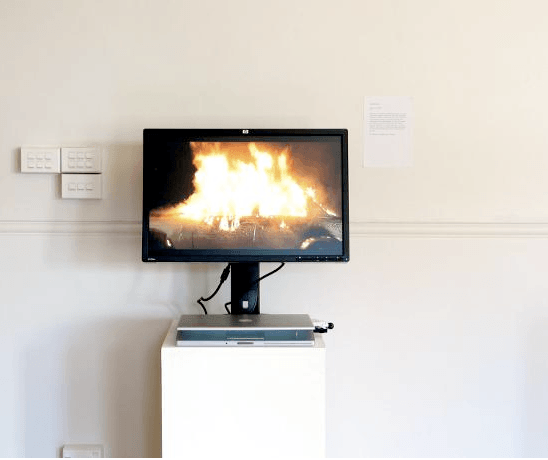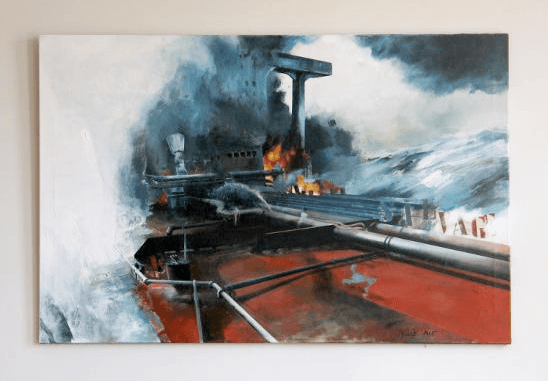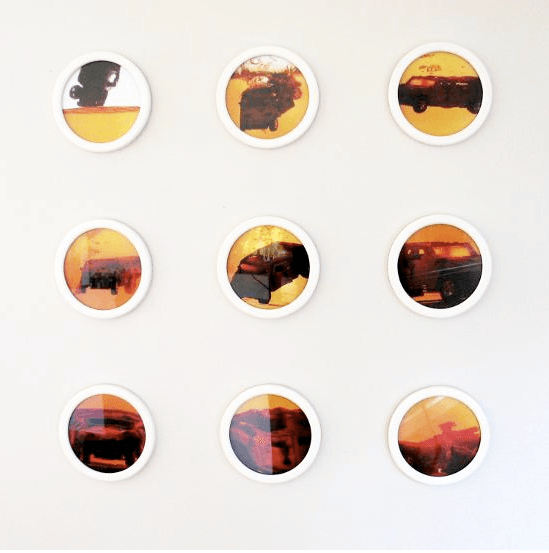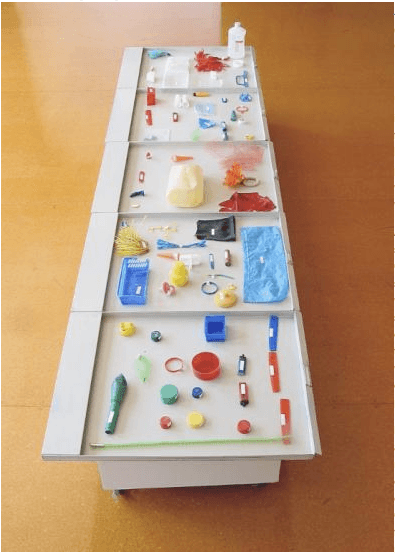DECEMBER, 2010.
Burn was held at Greenbench art project space in 2010 with support from The Physics Room and coincided with the Aotearoa Digital Arts Network Energetics and Informatics symposium. The exhibition included oil paintings, photographs, video and assemblage exploring the relationship between art and oil as part of a wider discourse about energy and information in media arts.
Artists included were: Sophie Jerram, NZ, Michael Marcovici, IT, Leigh Mitchell-Anyon, NZ, Felicity Priest, UK, Julian Priest, NZ, Superflex, DK, and Ubermorgen, DE.
Information and Images courtesy of Greenbench art project space, Whanganui http://greenbench.org/about
Michael Marcovici – After BP (2010), Digital Image
Marcovici’s work remedies a flaw in BP’s illustration of its Gulf rescue operation. Placed side-by-side in a before and after, the artist “decided to rework their images for better understanding”.
Superflex – Burning Car (2007), Film
Burning Car – the first film by SUPERFLEX depicts an empty car on fire. Filmed in a single long take, with a deadpan cinematic approach that features smooth panning shots and close-ups, Burning Car plays with the seductive vocabulary of car advertisements. The film can be seen as a response to the riots sweeping through Western Europe in 2005-2007, and media depictions of political unrest. In many ways, it confronts the cheap sensationalism that turned the burning car into a potent symbol for disorder.
Crude Oil Collection – Whanganui Rock and Lapidary Club
Uebermorgen – Deep Horizon (2010), Digital Oil Painting
“The supreme discipline of art – oil painting – is back”, according to Uebermorgen. Deep Horizon, a digital oil painting, is made using aerial images from a historic environmental disaster – the 2010 BP oil spill in the Gulf of Mexico. The images have been edited using special digital techniques to “produce a statement about the disconnection of form and colour and about contemporary and futuristic imaging procedures”. A compressor and consumer video editing-software are used to manually loop two frames, causing the image to become liquid.
For Uebermorgen this environmental disaster has allowed oil painting to evolve “into generative bio-art, a dynamic process the world can watch live via the mass media. Never before has this art form been as relevant and as visible as today…an 80,000 square mile ocean canvas with 32 million litres of oil”.
Sophie Jerram – Refined Life
Using recycled film technique mixed with contemporary live action, Refined Life borrows from footage from 1954 film Giant starring James Dean and 1980s television series Dallas.
Felicity Priest – Extinguish (1985), Charcoal and Pastel Drawing
Felicity Priest – Exocet (1985), Oil Painting
In 1984, Captain Ian Tew, skipper of the Salvage Tug Salvaliant, commissioned Priest to paint a particular event in which he had been the salvor. Tew, who was salvaging oil tankers caught in the midst of the war between Iran and Iraq (later known as the tanker war), wanted a depiction of an attack by exocet by Iraqi Air Forces and the subsequent demise of a fully laden tank called Al Ahood. Supplied with Tew’s personal account of the event and his extensive photographic reference, Priest made a body of work.
The oil painting Exocet shows the ship in the earlier stages of the salvage; all paint from the accomodation tower has burnt off and the structure is beginning to distort in the heat, whilst the fire still rages in the bowels of the ship. Part of the cargo of crude oil is still burning, the remainder yet to be extracted. Extinguish records a later stage of the salvage.
Leigh Mitchell-Anyon – Gas Guzzling Cars (2010), Photographs
At first glance, Leigh Mitchell-Anyon’s photographs show a range of gas guzzling utility vehicles completely submerged in oil. The cars in these images, however, are only toys – plastic replicas of standard issue U.S. Military Vehicles. Plastic, which we know is a derivative of oil, is being destroyed by the very thing that brought it into being. The reversal is a potent reminder of the juxtaposition these two products offer when brought together, destruction versus power.
Julian Priest – Plastic Drift (2004), Collection
“Grey, Sweden just visible, indistinct horizon, light snow fall, 0.5 mm hail shower bouncing off the pebbles with a pinging sound. Sand dusted white. Strong onshore wind, waves high.
After many days of walking the same walk along the same Gilleleje beach everyday and seeing a plastic red fish crate washed up on the beach, full of sand, moving its bulk to different spots on the beach at the whim of the tides, the weather and the waves, I decided to take the drift plastic plunge.
Months previously I had noticed a green rocket, one of many ammunition cases left after the explosive Gilleleje New Years Eve ritual arsenal detonation. Other firework detritus, such as flare parachutes and cardboard multi-shot rocket launch packs had long since bio-degraded. The green plastic rocket case remained. Last week I noticed a pink children’s dummy and a fuchsia plastic cup sitting in the lapping surf.
During the walk I found a piece of green plastic that looked like seaweed, I picked it up and so began a drift plastic collection.”










